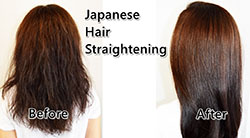
If you're looking for a permanent solution to your frizzy hair woes and have been looking into chemical straightening, you've probably come across one of the newer systems around - the Japanese straightening system, also known as thermal reconditioning. There are glowing reviews a-plenty to be found on the internet, and with claims that it can actually improve the condition of your hair alongside straightening it, who could resist? So, miracle beauty treatment or too good to be true? How does the Japanese hair straightening system work? This type of permanent hair straightening uses chemicals that basically alter the structure of the hair to leave it beautifully straight. Firstly an alkaline chemical solution is applied to the hair to break down the disulfide bonds within the hair that cause the kinks and curls - in the case of Japanese systems, the active chemical is Ammonium thioglycolate (this) which is one of the gentlest of these 'relaxer' chemicals. The additional step with Japanese systems is that once the bonds are broken, the hair is straightened section by section with hair irons and weighted boards are sometimes used to stretch out the hair to leave it perfectly straight. It's only then that a neutralizing solution is applied to the hair to set it permanently in its new straight form. This process isn't recommended for delicate Afro or previously chemically treated hair, as the risk of damage and breakage is a lot higher. A well-trained stylist will check on the condition of your hair before carrying out the treatment and adapt the chemicals and method used accordingly to minimize the chances of damage. So what are the pros? • Japanese straightening leaves hair poker straight and as the method smooths and flattens the cuticle of the hair, it should be lovely and shiny looking, making it an absolute godsend for anyone with curly unmanageable hair. That said, you should be wary of claims that it improves the actual texture of your hair - a smoother cuticle makes hair appear shiny and healthy but this doesn't mean that it isn't damaged or weakened. • With super straight hair, blow drying and styling time will be cut down massively. No more daily straightening - fantastic! • The treatment will last until your hair regrowth starts to show, so you should only need to have it done a few times a year to keep up the straight look. And the downsides? • As with any chemical process, you do risk causing significant damage to the condition of your hair. While even the best hair straightener is going to inflict its own damage with regular use, the risk is a lot higher with chemical processes. Many online reviews report that hair is brittle and dry afterward, leaving it in need of regular intensive conditioning. Different stylists and salons take different precautions too - some use specific heat protection formulas and pastes to avoid damaging delicate areas of hair, but not all salons use the same protective measures, so listen out for word of mouth recommendations. • The price varies from salon to salon, but it's certainly not a cheap process, so be prepared to fork out for it. If you find Japanese hair straightening on offer really cheaply, do be wary and check that the stylist is fully trained and using good quality products to carry out the process. • With the various stages and all of that flat ironing section by section, be prepared to spend a lot of time at the salon! It's a time-consuming process - depending on how thick or long your hair is, it could take around three to six hours. So weigh up the pros and cons - Japanese straightening can give fabulous results, but make sure you don't sacrifice the condition of your hair in the pursuit for super sleek locks.